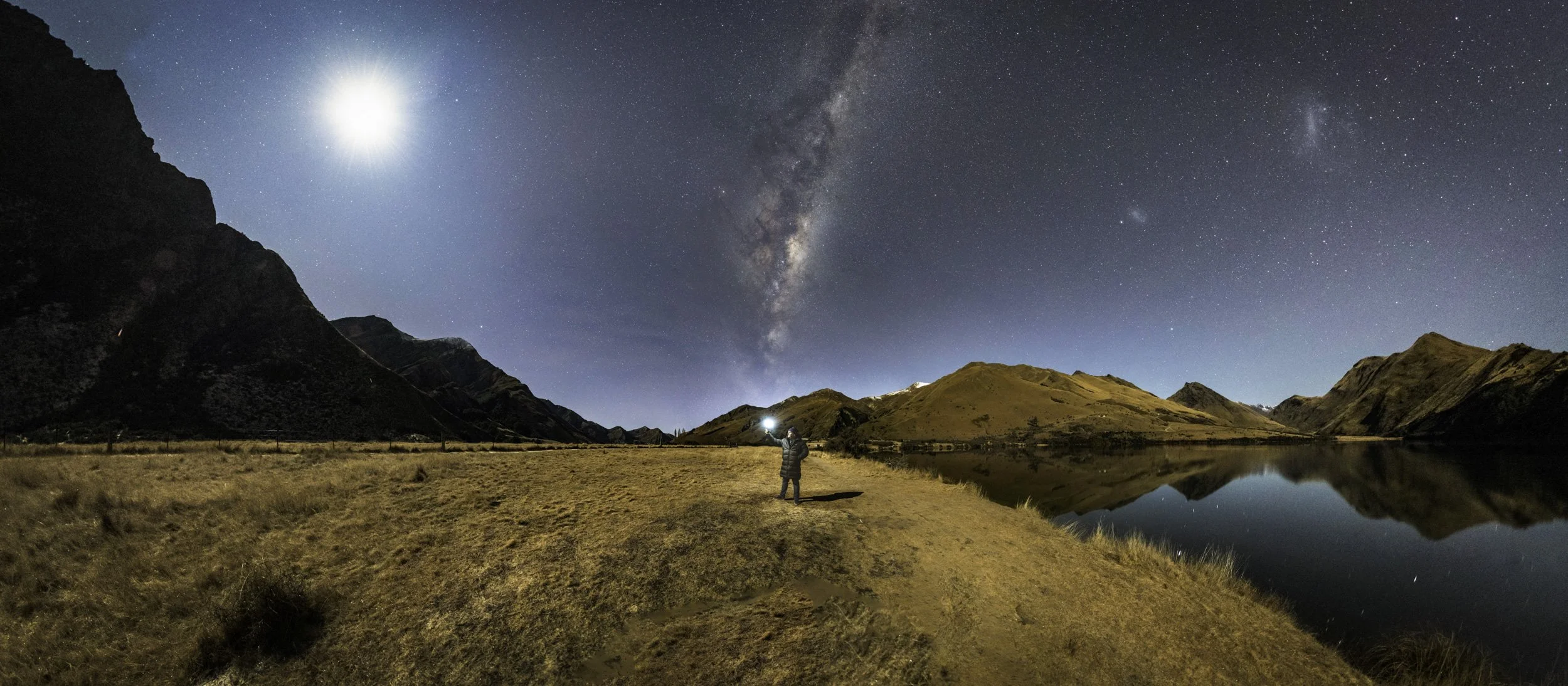Stargazing Winter 2024
Stargazing at Moke Lake with a 46% Moon
What an incredible winter it’s been so far. For the amount of natural snow our ski fields have received, there’s been some superb skiing and snowboarding to be had, and there's still a long way to go yet. It’s not just about the daytime adventures here in the Southern Lakes, our winter night skies have more than delivered.
We’ve welcomed guests from all over the world, from total stargazing novices through to space professionals what a stellar experience it’s been.
Whilst we’re firm believers in the best time to go stargazing is at night, no matter what time of year and preferably when then are as few clouds in the sky as possible, we can’t ignore the fact that when the nights get as cold as they do here in winter time, some nights are outstandingly clear. We’ve been fortunate enough to have a fair few of those evenings and our Unistellar eVscope has performed incredibly well.
Smart scopes are revolutionising modern terrestrial astronomy. For us, the main advantages are that we can transport them easily and they’re super fast to set up and start imaging. Rather than look through them with our eyes, they have a camera inside them that takes long exposure photographs that are exposed in real time on our iPad right in front of our eyes. It’s absolutely incredible to watch, and even more incredible to see the reaction our guests have.
Don’t worry, we understand the the power of seeing things with our own eyes. This is why we use binoculars alongside our smartscope. We start by looking with our eyes, then zoom in with the binoculars and then let the camera take over. The long exposure allows the collection of photons, that in some cases have been traveling across the Universe for millions of years, revealing structure and colours that we just can’t see with our eyes.
These have been some of our favorite targets this winter time, some are circumpolar, visible all year round. If they’re not visible when you embark upon your own Starry Night Adventure, there are others just as beautiful and impressive that we can show you.
Stargazing in the depths of winter in Queenstown NZ. Professional Astrophotography Portraits are part of your AuthenticAs Starry Night Adventure
We’re true believers in being lifelong learners, no matter how much you do something, there is always more to learn and develop. As part of your Starry Night Adventure, Simon will capture a series of single frame portrait images of you under the night sky, using either the Milky Way, or if you’re really lucky Kā Kurakura ō Hinenuitepō (The Aurora Australis) as the background. He’ll also take the time to shoot the individual images to create a panorama image. This captures a full 360 degree view of the landscape and more importantly the sky. The perfect way to document what you’ve been observing throughout your time stargazing
During the winter months, the core of the Milky Way is way overhead and as such difficult to get you and it in the same frame, even with our super wide angle lens. With this in mind, Simon has been very busy in our studio developing his techniques and skills stitching these panoramas together, changing up the way he’ll compose you to produce some truly stunning results.
A breathtaking Astroportrait Panorama with the Milky Way Core at the Zenith
If you’re getting into Astrophotography, your Starry Night Adventure can be tailored into a learning session, structured exactly to your needs. We’re very experienced with teaching people how to make the most out of their camera, day or night. With Astrophotography, it’s not just the camera setting which are important.
Understanding how the stars move across the sky at different times of year is key to planning and shooting those incredible astrophotographs that stop you in your tracks. The single best way to really understand this is to learn whilst looking at the stars. We can adapt our Stargazing element of the tour to really focus on what’s useful for astrophotography.
We delve into the popular and useful apps, showing you how to use them alongside your planning and shooting. As you’re photographing we will be discussing different editing techniques and how settings change throughout the moon cycle and also what to do when you're photographing the Aurora.
Moke Lake is an Astrophotographers dream location and the perfect place to learn new skills
Our Starry Night Adventures have an age limit of 5 and we understand that this can be a little frustrating for some of our guests. The main reason we do this is due to the nature of how we run our tours. We’re outside, and away from warm shelter. Quite simply, for our younger guests this really isn’t suitable at all. It’s not just winter either, even in the middle of summer, once the sun goes down the temperature can plummet.
With this in mind, we ran a successful trial a few weeks ago. It’s been something we’ve been thinking about and is definitely a bespoke Starry Night Adventure. We were contacted by a family who were staying in a holiday rental in Jacks Point, which has been designed so that light pollution at night is at an absolute minimum.
We were able to run the stargazing part of the tour from the garden, and then move to another location to take some photographs. This allowed everyone to stay warm, pop into the house now and then and generally stay just warm enough.
If this sounds like something you’re interested in, there are a few things we’d need to know first and take into consideration, so if you could emailus@authenticAs.org we can get the conversation started.
Stargazing from the garden of a Jacks Point Holiday Home in Queenstown, NZ
Astroportaits taken from a nearby location














